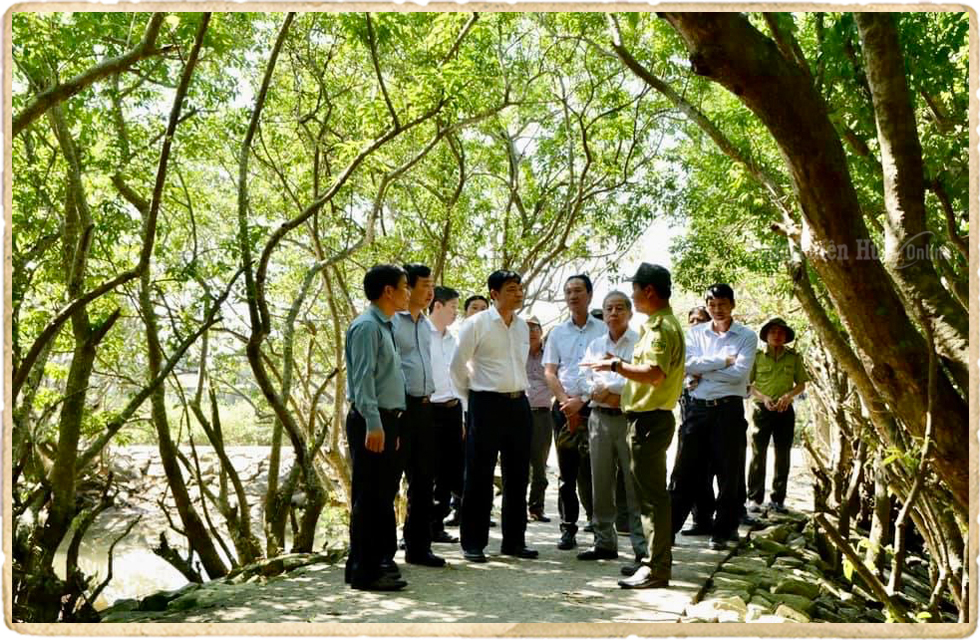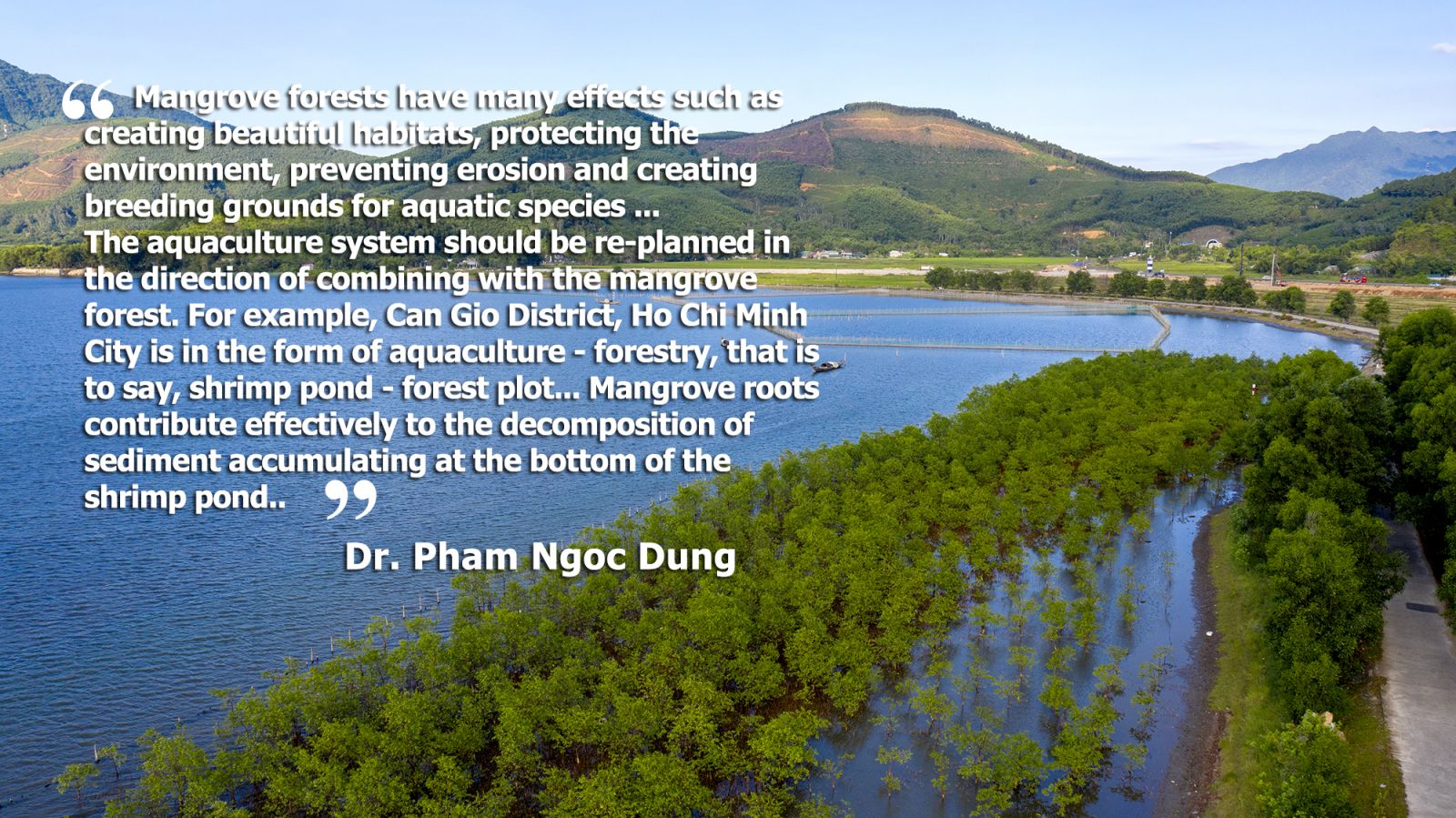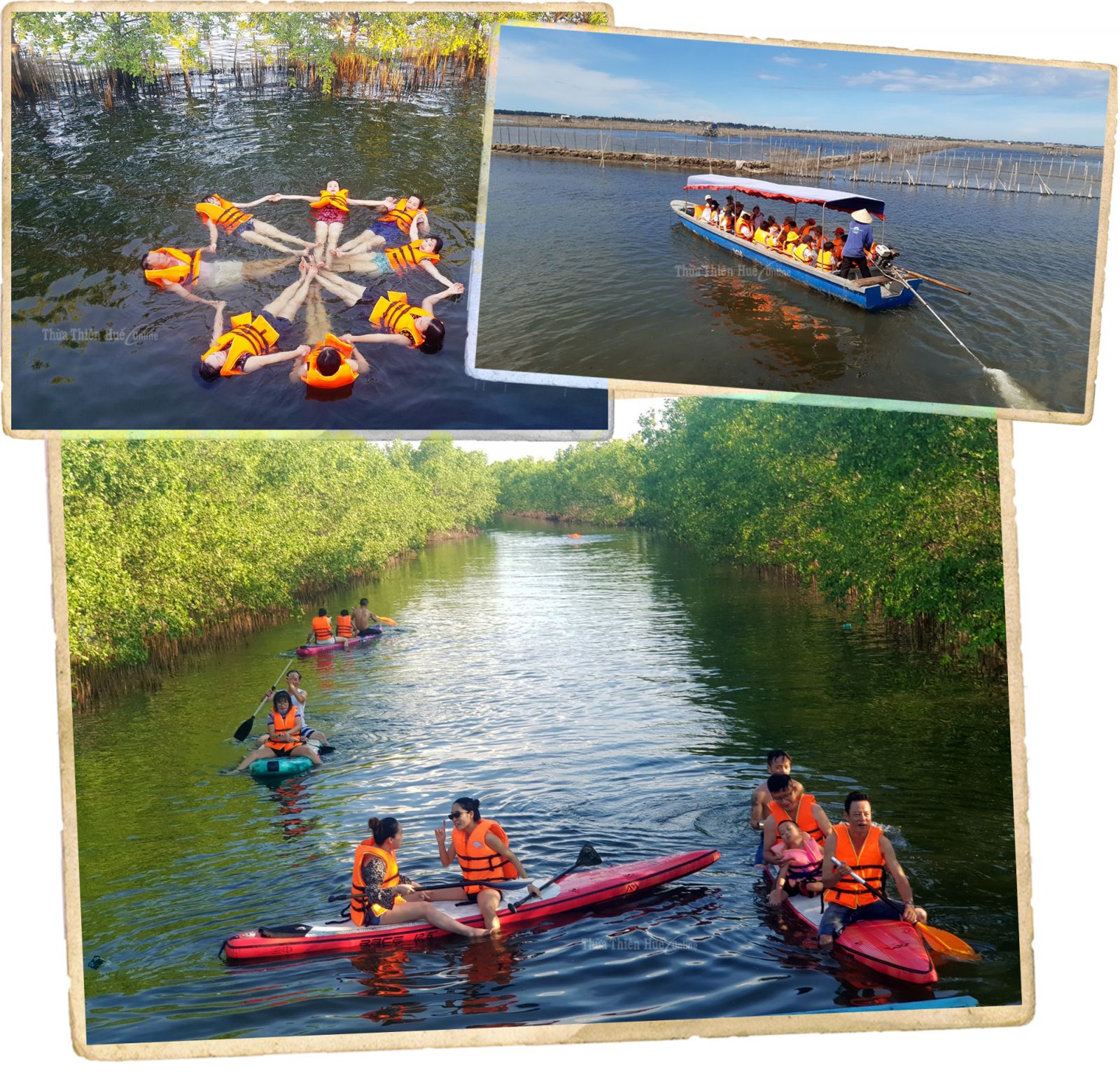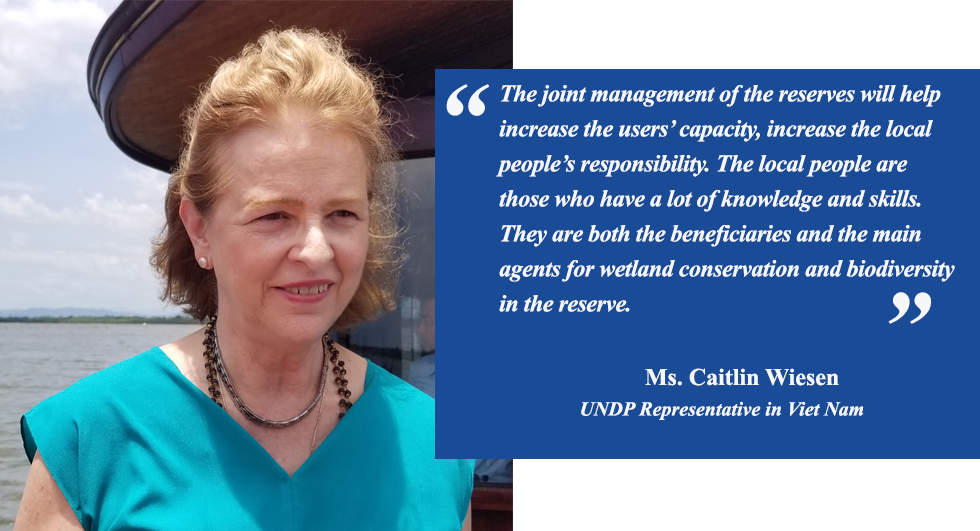In order to turn this unique ecosystem of Southeast Asia into a typical economic zone and a biosphere reserve of Thua Thien Hue, many ideas have been put forwards...
.png)
Dr. Pham Ngoc Dung, Deputy Head of the Provincial Forest Protection Sub-department has been involved in research work and mangrove afforestation projects for nearly twenty years. Starting in 2012, Mr. Dung experimentally planted mangroves in Ru Cha from seeds in Bu Lu Mangrove Forest, Phu Loc. The mangroves survived, creating a green space in Ru Cha every autumn. Thanks to care and protection, Ru Cha has become an ideal environment for aquatic species to develop, protecting the ecology for hundreds of households living along this area.
.jpg)
Mangrove forests are developed in many provincial areas.
In the past, the mangrove afforestation was not agreed upon because the soil conditions in Thua Thien Hue were unsuitable. After many times of successfully creating the artificial alluvial ground to plant mangroves in Ru Cha, this method has been applied to planting mangroves in Quang Loi, (Quang Dien). The forestry sector of Quang Ngai Province came to learn the experience and method of afforestation.

The working delegation of the Ministry of Agriculture and Rural Development visited Ru Cha Mangrove Forest
From the Ru Cha model, the area of mangroves planted by the Provincial Forest Protection Sub-department since 2016 has been about 126 ha. Concretely, Quang Dien District planted 50.5 ha (for 4 years with its effects brought into play); Huong Phong Commune (Huong Tra Town) 21.5 ha; Phu Dien Commune (Phu Vang) 30 ha, and Phu Loc District 24.5 ha.
Thanks to forests, shrimp and fish have a place to live and breed, creating livelihood for thousands of fishermen in Tam Giang-Cau Hai Lagoon.
Vice Chairman of the People's Committee of Quang Loi Commune (Quang Dien) - one of the localities benefiting from the lagoon - Mr. Phan Dang Bao said that the lagoon aquatic resources from the mangrove forest are a stable and sustainable source of livelihood for fishermen in the lagoon not only in Quang Loi. The aquatic product output in the mangrove forest has risen rapidly, providing fishermen with high and sustainable income. In 2019, the aquatic product exploitation job alone generated the revenue of more than VND 20 billion, a heartening figure.

According to Mr. Nguyen Viet Hung, Head of the Provincial Environmental Protection Sub-department, the mountainous and coastal areas will be safer when there are the belts of primeval forest and mangrove forest as a protection against the soil and sand erosion. Even for economic development, especially in agriculture, aquaculture, ecotourism, resorts, community tourism, scientific research, etc., it is also necessary to rely on the potential of biodiversity of forests, lagoons and sea.
.png)
For nearly 40 years of living with Cau Hai Lagoon, Mr. Tran Xuan Tam, an old fisherman, beside a cup of tea, pondered about the future of the younger generations of fishermen. Mr. Tam thought, “If 1 household with 4 people works as mobile fishermen, the amount of collected aquatic products just makes ends meet. Since 2016, the exploitation has been more difficult! How will my children and grandchildren live in the future?” Mr. Tam's worries were reported to many relevant departments, experts...
(1).JPG)
Most of the lagoon fishing boats use lừ (the folded, square-shaped fishing net with different mesh).
According to the Center for Social Research and Development (CSRD), the people's livelihood depends directly on the lagoon’s natural resources and environment.Meanwhile, this area comes under pressure from population growth, environmental pollution, rising fishing demand...Ms. Pham Thi Dieu My, Director of CSRD, said that this area is prone to natural disasters and extreme weather phenomena. The people need to be oriented and equipped with relevant knowledge integrated into the livelihood development plan. Moreover, it is necessary to raise the community’s awareness so that they can comply with and develop their livelihood in the orientation of resources protection.”

Tam Giang - Cau Hai plays a strategic role in the economic development of the province. Many tasks of scientific research and technology transfer have been implemented for the past 5 years with the funding of hundreds of millions of VND, including the development direction for typical aquatic products such as orange spotted spinefoot, spade-fish… Interestingly enough, in May 2019, the People's Committee of the province put the group of lagoon aquatic products, including Tam Giang - Cau Hai lagoon fish on the list of key products of Thua Thien Hue.
However, some experts claim that scientific research tasks need to form a chain, connect with the market and systematically solve problems so that the results of research can be scaled up or put into practice.

Many scientific research projects on aquaculture have been implemented in the lagoon.
In order to protect and exploit the lagoon sustainably, the people need to revert to the mode of production in harmony with nature. “Restructuring aquatic resources protection zones will be associated with the people's livelihood. Concurrently, the scientific and technological content for the projects implemented in the lagoon field need to be further increased,” Deputy Head of Provincial Fisheries Sub-department Phan Thi Thu Hong expressed her view. From a professional perspective, Ms. Hong said, “It is necessary to change the exploitation process accordingly and to have the head of the workforce in the lagoon. And in order to make a breakthrough, there is no better way than applying high technology, towards proactivity in water source, ” Ms. Hong stressed.
.png)
Along with shifting the livelihood in combination with ensuring the target of conserving and restoring ecosystem, many specific activities for each subzone of the reserve have been mapped out. Notably, the combination with the community-based ecotourism development to reduce the pressure of direct resources exploitation in the ecological restoration subzone is a direction which kick-starts the general situation.
Although not really as famous as Tonle Sap Lake, Cambodia, Inle Shan State Lake, Myanmar ..., the Tam Giang - Cau Hai lagoon system is known by domestic and foreign friends through the splendid photos and videos on the social networking sites and television channels.
.jpg)
Rowing sub boat to enjoy scenery and experience fishing on Tam Giang Lagoon.
3 years ago, on Ngu My Thanh Lagoon (Quang Loi, Quang Dien), the form of community- based tourism appeared: Watching the sunset on Tam Giang Lagoon, welcoming the dawn, rowing sub boat to pick fruits and cork leaves for processing food... This program has the involvement of the local community and the activities of experience as tung chài (casting fishing net), nơm cá (catching fish with a trapping basket)…During the tourist season, according to Ms. Luong Thi Hien, a tour guide in this community tour, she, on average, receives 400 tourists per month.
At the symposium on lagoon tourism, Mr. Nguyen Dinh Thanh, Deputy Director of Dai Bang (Eagle) Tourism Joint Stock Company, which is organizing ecotourism tours on Quang Loi Lagoon, said that this tour is gaining in popularity. The local people have new jobs such as craft demonstration, rowing and selling seafood to tourists, so their income increases significantly.

Tourism in Ngu My Thanh Lagoon (Quang Loi, Quang Dien) and Chuon Lagoon (Phu An, Phu Vang) attract the most tourists in the lagoon system.
Meanwhile, Chuon Lagoon (Phu An, Phu Vang) has the advantages for developing culinary tourism services with fresh, delicious and natural fish, shrimp, crabs, especially dorab pancakes that appear many times on the travel discovery channels. Chuon Lagoon is the destination for many European and Asian film crews and domestic and foreign photographers.
“Further, Loc Binh Commune is welcoming some Hanoi businesses, who learn about the resort investment in Quen Mountain because this scenic area offers the panorama of Cau Hai Lagoon and is suitable for ecotourism,” Mr. Luong Trong Hau, Vice Chairman of People's Committee of Loc Binh Commune revealed. “If ecotourism is developed in the reserves, the pressure on lagoon will be reduced. The people will shift to aquaculture for tourism, have stable jobs and better invest in protecting the lagoon ecosystem,” Mr. Hau expected.
Mr. Nguyen Van Phuc, Deputy Director of the Provincial Department of Tourism, judged that the implementation of the mangrove afforestation project has contributed to a better ecological environment in the lagoon. Besides, it also helps the people to have more income from mangrove forest products. "We encourage the tourist businesses to incorporate the communication on the ecological environment protection of the lagoon and the value protection of the mangrove forest into the tour program," said Mr. Phuc.
Evaluating the potential of tourism in this field, some travel agencies said that we should make investment in order to have more attractive new products and should not follow the old mode.

Tourism development contributes to promoting the value and reducing the pressure on the lagoon
Vice Chairman of the Provincial People's Committee Phan Thien Dinh judged, “We are lacking the investment in essential infrastructure for tourism development. It is necessary to plan and rearrange nò sáo (stake nets) and tourist wharves. Besides, there is a lack of big investors. Good planning will facilitate the zoning of development for different directions, including tourism.”
According to Mr. Dinh, the province is planning to invest in a large fishing port capable of fishing and processing in Cau Hai area. In addition, the ports exclusively for tourism will be re-planned. The investment in routes will be continued in the future in the direction of both protecting the lagoon and mobilzing households to face the lagoon, using the lagoon as a frontage to form urban areas and residential areas.
The path to turn these plans into reality lies ahead. Developing the coastal areas, Tam Giang - Cau Hai Lagoon into a typical economic zone - the biosphere reserve will be the target for which the authorities and the community aim on the journey of conservation and development.
